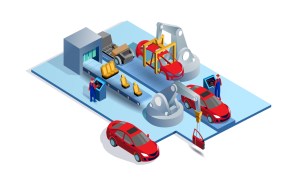When you’re driving somewhere for the first time, you look for road signs and landmarks to make sure you’re going the right way. The same is true for seismic changes in industries like automotive manufacturing – and there’s been at least one major signal in Canada that the journey towards electric vehicles is about to accelerate.
In late April, the federal government announced it would invest $259 million through the Ministry of Innovation, Science and Industry to support the country’s first full-scale commercial electric vehicle production facility at General Motors’ CAMI Assembly Plant in Ingersoll.
Beyond the thousands of jobs that the plant will generate, the partnership with the public sector and GM could represent a turning point in how a key segment within the industrial sector shifts to more sustainable products.
According to data published by Natural Resources Canada, burning just a single litre of gasoline produces approximately 2.3 kg of CO2. Multiply that over the course of 12 months and that car’s pollution levels equal 4,600 kg. Now think about all the vehicles that typically fill our streets and highways and it’s easy to see why electric vehicles offer a necessary alternative.
This isn’t the kind of transition that happens without significant education and effort. For instance, J.D. Power recently released a study that showed Canadians are less likely than those in the U.S. to choose an electric vehicle as their next purchase. This was attributed to concerns over the purchase price, the range of available models and how well the vehicles will perform
Most of these issues can easily be resolved by using sites like EV Plug N’ Drive, which showcases a diversity of electric vehicles and helps consumers find their best match based upon their lifestyle. The National Bank of Canada has also offered detailed information about how electric vehicles can be more affordable, lighter and faster than traditional cars. The fact they also don’t generate fossil fuel emissions should resonate with the many Canadians who are increasingly concerned about the impact of climate change.
It’s not just a matter of Canadians learning more about electric vehicles, however. The world might never have moved away from traditional forms of transportation like the horse and buggy were it not for advances in business such as mass production. The assembly line made producing vehicles fast and efficient, creating a pent-up demand among the public.
The development of Canada’s first electric vehicle facility could have a similar impact in making cars of the future more widely available. This in turn might lead more of us to take them for a test drive.
Others in the automotive sector – and even those in other parts of the manufacturing industry – might also want to consider other strategic lessons the government’s investment announcement could teach them:
1. The future is now
Discussions about sustainability in manufacturing can involve a lot of “somedays.”
Many firms are hoping to decrease their reliance on fossil fuels, for example . . . some day.
Some day, the demand for environmentally-friendly products and services will reach the point where ignoring the trend will hurt the bottom line.
There might be a number of manufacturers who hope, some day, to dedicate more time and resources to figuring out what it will take to change their operating models.
Putting off the future in perpetuity is a mistake, however. It puts businesses at risk of being out of step with their customers’ core values. Competitors may be quick to capitalize on a lack of other firms entering a particular niche. And once a market shift begins in earnest, it can be difficult for companies to make up for ground they lose
2. Innovation is always rewarded
Trying new approaches can involve great uncertainty, but those who make the leap often find themselves glad they did.
A decade ago, for instance, many companies hadn’t heard about the potential of cloud computing. Some resisted the move from hosting all their applications and infrastructure on premise to one where they could be hosted in the cloud.
First movers, however, quickly found they had all the advantages. These included more room that was once taken up by servers, less time updating and patching software, the ability to scale up IT resources when demand spiked and more.
The decision to manufacture electric vehicles will quickly allow the innovators to differentiate themselves from rivals. They will stand a better chance of developing positive relationships with consumers, and they may attract more outside investment to support their pioneering efforts.
3. Spending money saves money
Any viable business growth strategy depends on having a good handle on your finances. This can create roadblocks for sustainability programs, though, because at first glance it looks expensive to go from producing one kind of product to another.
Invest Ontario has offered a primer that outlines the incredible cost advantages of renewable energy in automotive manufacturing. It shows that, in many respects, Canada is in an ideal position to compete versus other jurisdictions around the world.
This is a resource that will pay for itself over time. More importantly, it will ensure future generations are not only able to get from A to B, but that they’ll inherit a planet that survives.
It’s important to recognize that as promising as the GM factory plans are, they represent just one step in a larger movement to electric vehicles, and to more sustainable manufacturing in general. The opportunity for other firms to embrace the future and reap the rewards is here. In other words, you might say manufacturers are in the driver’s seat.

























